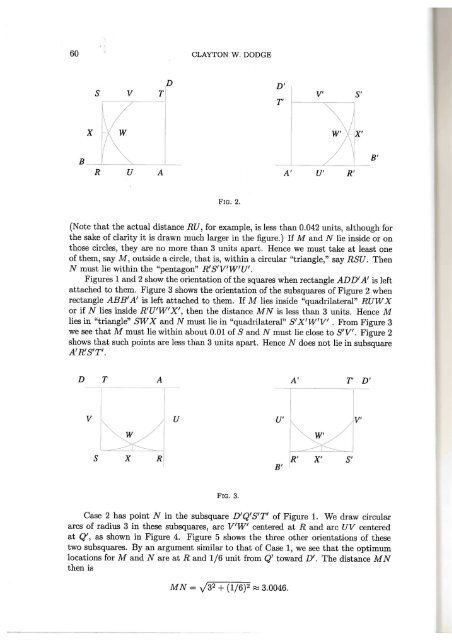You also want an ePaper? Increase the reach of your titles
YUMPU automatically turns print PDFs into web optimized ePapers that Google loves.
60 CLAYTON W . DODGE<br />
PROBLEM DEPARTMENT 61<br />
s<br />
X w W'<br />
D'<br />
T'<br />
S'<br />
c Q D D' W' Q' C'<br />
\ S'<br />
I<br />
s<br />
B<br />
B'<br />
_itl<br />
p T'<br />
V'[]P'<br />
B R U A A' R' B'<br />
R u A A' U' R'<br />
FIG . 4.<br />
FIG. 2.<br />
(<strong>No</strong>te that the actual distance RU, for example, is less than 0.042 units, although for<br />
the sake of clarity it is drawn much larger in the figure.) If M and N lie inside or on<br />
those circles, they are no more than 3 units apart. Hence we must take at least one<br />
of them, say M, outside a circle, that is, within a circular "triangle," say RSU. Then<br />
N must lie within the "pentagon" R'S'V'W'U'.<br />
Figures 1 and 2 show the orientation of the squares when rectangle ADD' A' is left<br />
attached to them. Figure 3 shows the orientation of the subsquares of Figure 2 when<br />
rectangle ABB' A' is left attached to them. If M lies inside "quadrilateral" RUW X<br />
or if N lies inside R'U'W' X', then the distance M N is less than 3 units. Hence M<br />
lies in "triangle" SW X and N must lie in "quadrilateral" S' X'W'V' . From Figure 3<br />
we see that M must lie within about 0.01 of Sand N must lie close to S'V'. Figure 2<br />
shows that such points are less than 3 units apart. Hence N does not lie in subsquare<br />
A' R'S'T'.<br />
In Case 3, point N lies in the subsquare C' P' S' Q'. Consider points M~ an~ N1<br />
with distances w, x, y, and z from the sides of their subsquares, as show~ m Figure<br />
6. <strong>No</strong>te the distances D1, D 2 , D 3 , and D 4 , which show some of the poss1ble routes<br />
the ant might take. <strong>No</strong>te that the top two orientations duplicate the bottom two. To<br />
maximize the horizontal distances at 3 units, distances D1 and D2 show that we must<br />
have w = x andy= z. Furthermore, x, y E [0, ~].<br />
T<br />
s<br />
A<br />
u<br />
R<br />
l --<br />
T'<br />
D'<br />
w· ~~~ v·<br />
S'<br />
I Q'<br />
T --<br />
D T A A' T' D'<br />
v u U' V'<br />
w<br />
W'<br />
s R R' X' S'<br />
B'<br />
FIG. 3.<br />
Case 2 has point N in the subsquare D'Q'S'T' of Figure 1. We draw circular<br />
arcs of radius 3 in these subsquares, arc V'W' centered at R and arc UV centered<br />
at Q', as shown in Figure 4. Figure 5 shows the three other orientations of these<br />
two subsquares. By an argument similar to that of Case 1, we see that the optimum<br />
locations forM and N are at Rand 1/6 unit from Q' toward D'. The distance MN<br />
then is<br />
MN = j3 2 + (1/6) 2 ~ 3.0046.<br />
1 l<br />
R bi s ~<br />
--------- v I<br />
u ~~ T I<br />
A -<br />
FIG. 5.<br />
We have the distances<br />
Dr = (1 - 2y) 2 + 3 2 ,<br />
D~ = (2x) 2 + 3 2 ,<br />
S'<br />
Q'<br />
Q' S'<br />
V' ~ ---- ---<br />
D'<br />
W'<br />
\<br />
V'<br />
W'<br />
D'<br />
T'<br />
D '
















